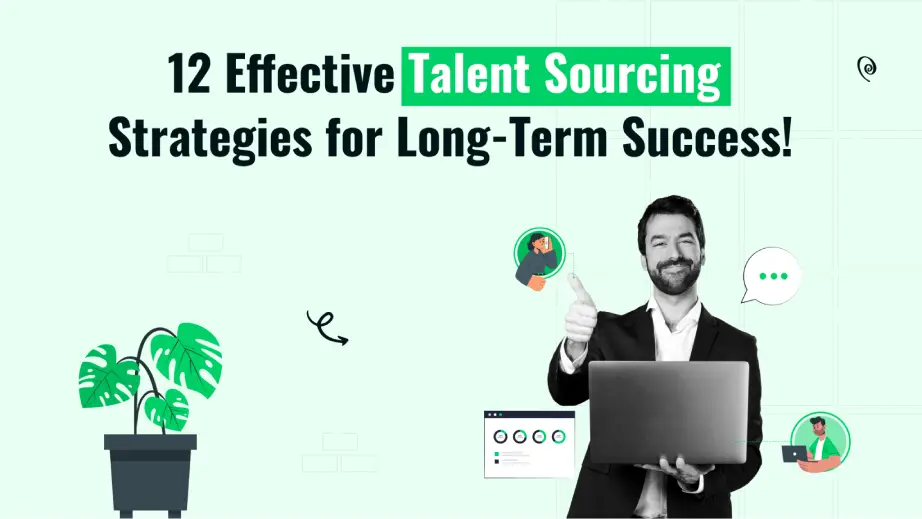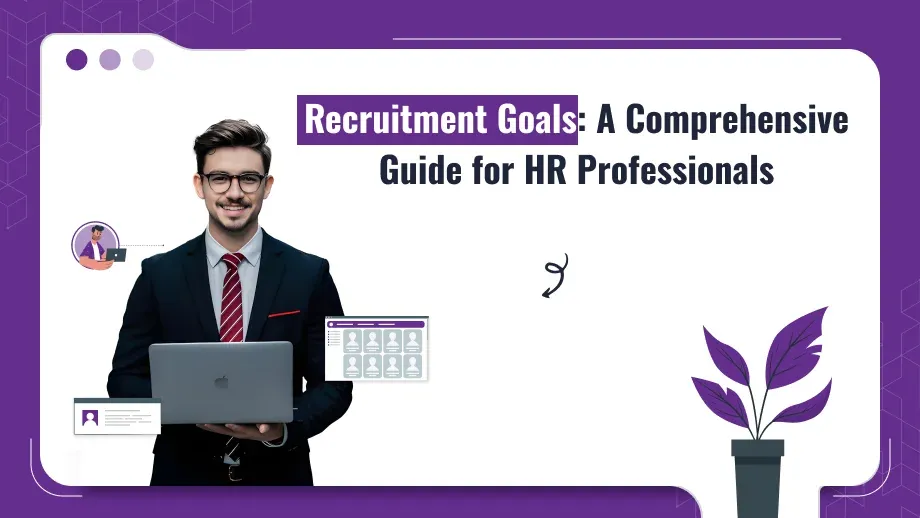To budget their candidate sourcing process, companies should assess resource needs (e.g., job boards, software, agency fees), estimate the number of hires, allocate a portion of the recruitment budget accordingly, track channel effectiveness, and regularly evaluate and adjust the budget.
Grab a chance to avail 6 Months of Performance Module for FREE
Book a free demo session & learn more about it!
-
Will customized solution for your needs
-
Empowering users with user-friendly features
-
Driving success across diverse industries, everywhere.
Grab a chance to avail 6 Months of Performance Module for FREE
Book a free demo session & learn more about it!
Superworks
Modern HR Workplace
Your Partner in the entire Employee Life Cycle
From recruitment to retirement manage every stage of employee lifecycle with ease.


Seamless onboarding & offboarding
Automated compliance & payroll
Track performance & engagement
12 Effective Talent Sourcing Strategies for Long-Term Success!
- Talent Sourcing
- 17 min read
- June 30, 2023

Unlocking a wealth of talent is the ultimate key to a company’s success, and finding exceptional individuals who can propel your organization forward is no easy feat.
In a world where competition for top-notch professionals is fierce, businesses must adopt innovative and effective talent sourcing strategies. This blog reveals the holy grail of talent management and sourcing strategies that have proven to be catalysts for long-term triumph.
Brace yourself for a captivating recruiting process journey through the art of sourcing in recruitment. In this blog, we will explore 12 powerful strategies that will empower your organization to attract, engage, and retain exceptional talent.So, are you ready to revolutionize your talent acquisition process and unleash the potential of your workforce?
The talent sourcing process is a systematic approach to identifying, attracting, and engaging qualified candidates for job openings within an organization. It involves proactive efforts to locate and connect with a potential talent pool, both actively seeking employment and those who may be passive job seekers.
Recruiters and hiring managers utilize various techniques, such as resume screening, interviewing, and assessment, to evaluate and select the best candidates for further consideration in the hiring process. Some even use efficient software such as talent assessment tools.
In essence, the goal of sourcing talent is to build a robust pipeline of qualified candidates and ultimately fill job vacancies with the most suitable talent.
- Role of Talent Sourcing to Get Qualified Candidates
- What are the Types of Talent Sourcing in HR?
- 7 Benefits of Talent Sourcing For an Hiring Manager
- What is the Difference Between Recruitment and Talent Sourcing?
- What are Candidate Sourcing Strategies?
- 12 Effective Talent Sourcing Strategies You Must Know!
- 1. Rely on a recruitment database:
- 2. Harness the power of social media:
- 3.Employee referrals are a great tool:
- 4. Craft compelling job postings:
- 5. Tap into internal talent for strategic recruitment:
- 6. Establish a robust sourcing pipeline:
- 7. Foster collaboration with team leaders or managers:
- 8. Engage candidates with outreach messages:
- 9. Do not forget about follow-up emails:
- 10. Monitor hiring metrics:
- 11. Respect schedule of candidates as well:
- 12. Use offline channels:
- Parting Thoughts
Role of Talent Sourcing to Get Qualified Candidates
Talent sourcing plays a vital role in securing qualified candidates for job positions within an organization. It helps in several ways. Firstly, it expands the candidate pool by actively seeking out individuals who may not be actively job hunting, tapping into a wider talent network. Secondly, it allows for a targeted approach, focusing on specific skills and qualifications required for the job.
This ensures that the candidates identified closely match the job requirements. Lastly, sourcing talent provides access to passive candidates who are not actively seeking job opportunities but may be open to the right offer. Engaging with these candidates increases the chances of finding highly skilled and experienced professionals, contributing to the overall quality of the talent pool.
What are the Types of Talent Sourcing in HR?
In HR, there are several types of sourcing strategies that organizations use to identify and attract candidates for job positions. Here are some common types of sourcing in HR:
1. Active Sourcing:
Active sourcing is a proactive approach in HR that involves actively searching for candidates through various channels to fill job positions. Recruiters take the initiative to reach out to potential candidates through online job boards, career fairs, and professional networking events. They utilize candidate sourcing tool and techniques to identify individuals with the desired skills and qualifications.
By actively engaging with candidates, HR professionals can build relationships, assess their suitability for specific roles, and encourage them to apply for open positions. Active sourcing ensures a steady influx of qualified candidates, expands the talent pool, and increases the chances of finding the right fit for the organization’s needs.
2. Passive Sourcing:
Passive sourcing is a strategic sourcing method in HR that aims to identify and engage with candidates who may not be actively seeking job opportunities.
Recruiters employ various tactics to reach passive candidates, such as leveraging professional networking sites, industry events, and targeted outreach. These individuals are often highly skilled, experienced, and content in their current roles. By approaching passive candidates and showcasing the potential benefits of joining their organization, HR professionals can attract top talent who may not have otherwise applied. Passive sourcing expands the candidate pool, brings in candidates with unique skill sets, and provides opportunities to fill critical positions with exceptional individuals. Again, you can rely on one of the best sourcing tools for recruiters to source passive candidates effortlessly.
3. Internal Sourcing:
Internal sourcing is a strategic approach in HR that focuses on identifying potential candidates for job openings from within the organization. This method recognizes the value of existing employees and their potential for growth and advancement.
HR professionals actively promote career development and progression opportunities, encouraging employees to apply for internal job postings. By leveraging internal talent, organizations can retain institutional knowledge, reward and motivate employees, and foster a culture of internal mobility. Internal sourcing also saves time and resources associated with external talent recruitment processes.
Additionally, it boosts employee morale and talent assessment tool, as individuals perceive growth opportunities within the organization, enhancing overall retention and talent development strategies.
4. External Sourcing:
External sourcing is a key sourcing strategy in HR that involves seeking candidates outside of the organization to fill job positions. They are also use talent management system for this process.
HR professionals utilize various methods to attract external candidates, such as posting job openings on websites, advertising in newspapers, utilizing social media platforms, and partnering with recruitment agencies. This strategy widens the talent pool and brings fresh perspectives, skills, and experiences to the organization.
External sourcing allows organizations to tap into a diverse range of talent and access candidates who may possess specialized expertise or bring a different industry perspective. It helps fill skill gaps and ensures a continuous influx of new talent to support the organization’s growth and innovation.
5. Referral Sourcing:
Referral sourcing is a powerful sourcing strategy in HR that harnesses the networks of current employees to identify potential candidates.
Through referral programs, employees are encouraged to refer qualified individuals for job openings within the organization. This method taps into the power of word-of-mouth recommendations and leverages the trust and knowledge employees have about the organization’s culture and values.
Referral sourcing incentivizes employees through referral bonuses or rewards for successful hires. It not only expands the candidate pool but also enhances the quality of candidates by attracting individuals who align with the organization’s values and are more likely to thrive in the company’s environment.
Referral sourcing fosters a sense of employee engagement, strengthens employee connections, and contributes to a positive recruitment experience.
6. Talent Pipelining:
Talent pipelining is a proactive sourcing or talent acquisition strategy in HR that focuses on building and nurturing relationships with potential candidates even before specific job openings arise.
HR professionals engage with these individuals through various means such as networking events, industry conferences, and online platforms.
By establishing a recruiting pipeline software, organizations can maintain a pool of qualified candidates who have shown interest in the company and possess the desired skills and qualifications. This approach ensures a continuous supply of potential candidates, reduces time-to-hire, and enables organizations to quickly respond to talent needs when vacancies arise.
Talent pipeline process also helps in creating a positive employer brand, as candidates are already familiar with and interested in the organization, increasing the likelihood of successful recruitment and retention.
Read More – Grow Your Team Better, Faster With An Employment Referral Program
7 Benefits of Talent Sourcing For an Hiring Manager
Here are some key benefits of talent sourcing for a hiring manager:
1. Access to a wider pool of talent:
Sourcing candidates allows hiring managers to tap into a larger talent pool beyond the traditional methods of job postings and referrals. This expands the reach and increases the chances of finding high-quality candidates who may not be actively seeking job opportunities but possess the desired skills and experience.
2. Improved candidate quality:
By actively searching for talent, hiring managers can proactively identify individuals who possess the specific qualifications and skills required for a particular role. This ensures a higher quality of candidates compared to relying solely on incoming applications or passive job seekers.
Also, See: Buyer’s Guide: Top 5 HCM Solution Software Of 2024
Unable to source the right candidates? Don’t worry, we’ll help you!
All you need is Super Recruit – the all-in-one recruiting system to attract, hire and retain top talent for your organization. With Super Recruit, you will never lose candidates due to slow or poor candidate experience!
3. Reduced time-to-hire:
Sourcing talent helps expedite the hiring process by identifying potential candidates early on and initiating conversations with them. This proactive approach can shorten the time it takes to fill a position, as hiring managers can engage with candidates who are already interested in the organization and potentially ready to make a career move.
4. Enhanced employer brand:
A well-executed talent sourcing strategy allows hiring managers to showcase their organization’s strengths, values, and opportunities to potential candidates. By proactively engaging with top talent, the hiring manager can build positive relationships, establish the company as an employer of choice, and enhance its employer brand.
5. Better cultural fit:
Sourcing talent enables hiring managers to not only evaluate candidates based on their skills and experience but also assess their compatibility with the organization’s culture. By targeting candidates who align with the company’s values and work environment, hiring managers can increase the likelihood of a successful and long-term employee-employer relationship.
6. Competitive advantage:
In today’s competitive job market, attracting and securing top talent is essential for organizations to thrive. Talent sourcing or talent acquisition software gives hiring managers a competitive edge by actively identifying and engaging with high-potential candidates before they are approached by competitors. This can help the organization secure the best talent, particularly for niche or high-demand roles.
7. Cost savings:
While talent sourcing may require an initial investment of time and resources, it can lead to long-term cost savings. By proactively sourcing talent, hiring managers can reduce reliance on external recruitment agencies or job advertising platforms, which can be costly. Additionally, by attracting highly qualified candidates, organizations can potentially reduce employee turnover and the associated expenses of hiring and training new staff.
What is the Difference Between Recruitment and Talent Sourcing?
Just talent acquisition and recruitment process, professionals often get confused with recruitment and talent sourcing.
Talent sourcing aims to transform individuals who have not yet applied into potential applicants, while recruitment involves converting applicants into employees. Talent sourcing serves as the initial stage of the recruitment process and plays a crucial role in establishing a strong talent pipeline.
The relationship between talent sourcing and recruiting is mutually beneficial. Recruiters primarily source talent for specific job openings, utilizing platforms like LinkedIn and job boards. They oversee the entire recruitment process, collaborating with talent sourcing representatives as necessary.
A talent sourcer typically concentrates on generating leads for a limited number of job openings. They closely collaborate with recruiters and hiring managers, with the objective of discovering and identifying talented individuals, creating leads, and generating interest in available positions. Sourcing and recruiting are interconnected aspects that work together, although they have distinct roles and responsibilities.
What are Candidate Sourcing Strategies?
Candidate sourcing strategies are techniques that help recruiters as well as hiring teams to examine and attract potential candidates. These strategies for sourcing candidates may include methods such as job postings on relevant platforms, networking and referrals, direct sourcing through online databases or social media, attending industry events and job fairs, and utilizing recruitment agencies. The goal is to proactively search and engage with qualified individuals to build a talent pipeline and increase the chances of finding suitable candidates for specific roles.
12 Effective Talent Sourcing Strategies You Must Know!
Take a look at 12 talent sourcing strategies to get your hands on the top talent for your organization:
1. Rely on a recruitment database:
Many companies and hiring agencies maintain their own dedicated databases for this purpose. These databases serve as a valuable resource for hiring managers, who can easily search through them to identify potential candidates when new positions arise. An applicant tracking system (ATS), recruiting software or talent acquisition software can be utilized within these databases to streamline the candidate selection process. Additionally, candidate relationship management systems provide a means to explore previously applied candidates and find suitable matches. By storing and organizing candidate information within these databases, hiring managers can quickly review and access relevant details whenever necessary, facilitating an effective and efficient recruitment process.
Talent acquisition teams can also take advantage of the vast pool of potential candidates available on social media platforms to enhance your recruitment strategy. Incorporating social media into your talent acquisition efforts can yield fruitful results. Scan these platforms to identify individuals whose skills and experience align with your job requirements. Engaging with candidates on social media can also boost your organization’s brand presence and attract top talent.
Leverage employment-oriented platforms to post detailed job descriptions and interact with professionals in your industry. Utilizing social media for candidate sourcing opens up avenues for networking, showcasing your company culture, and ultimately finding suitable candidates who can contribute to your organization’s success.
3.Employee referrals are a great tool:
Employee referrals is a widely adopted talent sourcing strategy by most talent acquisition teams and recruiters. A good number of organizations have established referral programs that incentivize employees with bonuses for successfully recommending candidates. By actively encouraging existing employees to refer suitable candidates for relevant job openings, you tap into their networks and benefit from their firsthand knowledge of potential talent. Employee referrals are often regarded as a cost-effective method by hiring managers.
Additionally, consider allowing current employees to apply for new roles, as they may possess the skills and qualifications necessary for the positions. Embracing employee referrals can lead to quality hires while fostering a sense of engagement and collaboration within the organization.
4. Craft compelling job postings:
Job postings with an effective job description play a pivotal role in conveying educational requirements and essential skills to potential or prospective candidates. By creating effective job postings, you can streamline the hiring process and attract top talent. Utilize various online portals to share your job postings and reach a wider audience. Choosing the right platform ensures maximum visibility for your job post. Ensure that your job posting includes all crucial details to optimize the recruitment process. By providing comprehensive information, you enhance the likelihood of attracting the right candidates. Thoughtfully crafted job postings have the potential to make your recruitment efforts more efficient and successful.
5. Tap into internal talent for strategic recruitment:
Recognizing the value of internal talent, many hiring professionals regard it as a prime source for recruiting potential candidates. Embrace the opportunity to allow existing employees to apply and evaluate their performance for current and future positions. Consider offering promotions or repositioning current professionals, which can provide a refreshing career change for those seeking new challenges. Assessing internal talent not only aids in the efficient utilization of resources but also saves valuable time in the recruitment process. Hiring managers often prioritize recruiting from within as existing professionals possess familiarity with the workplace and are more adept at adapting to their new roles. Harnessing internal talent promotes growth, loyalty, and the development of a robust talent pipeline within your organization.
6. Establish a robust sourcing pipeline:
Hiring managers commonly maintain a comprehensive database of candidates who have applied for open job roles. This sourcing pipeline serves as a valuable resource, enabling the identification of the right candidates possessing crucial skills and qualifications. Each time a candidate applies for a specific role, their information can be added to the database for future reference. By incorporating essential details into the pipeline, you establish a repository of potential candidates for future openings. This proactive approach ensures a continuous connection with potential talent, streamlining the recruitment process and enhancing your ability to source qualified candidates efficiently when new opportunities arise.
7. Foster collaboration with team leaders or managers:
Having a strong collaboration with team leaders or managers is vital for HR managers to gain a thorough understanding of their expectations and job requirements. It is crucial to ensure alignment and agreement on the desired qualifications and skills. Schedule meetings with team leaders to delve into their vision, goals, and specific needs. Clearly define the number of open positions upfront before initiating the candidate search process. Throughout the recruitment process, maintain consistent communication with team leaders, keeping them informed about progress and sharing updates on candidate selection. By nurturing this collaboration, HR managers can optimize the recruitment strategy and ensure a seamless integration of new hires within the teams.
8. Engage candidates with outreach messages:
To effectively engage with potential candidates and provide insights into your organization, focus on creating compelling outreach messages. Begin with a captivating introduction line that piques their curiosity and entices them to read the entire message. Within the message, convey the job requirements and emphasize the benefits of joining your organization. Include relevant information specific to the job role to showcase the value and potential opportunities available. By crafting targeted and informative outreach messages, you can capture the attention of candidates, spark their interest, and encourage them to explore further, ultimately increasing the chances of attracting qualified talent.
Read More – 11 Tools For Recruitment That Will Give You a Competitive Edge
9. Do not forget about follow-up emails:
Sending follow-up emails to potential candidates is a valuable practice employed by hiring managers. These emails demonstrate your continued interest in learning more about their skills and experience. Occasionally, candidates who possess the necessary qualifications may not join for personal reasons. In such cases, if a suitable job opening arises, you can utilize follow-up emails to inform them about the opportunity. By reaching out and expressing your interest, you create a channel for communication and increase the likelihood of attracting talented individuals who may have previously shown interest in your organization. Follow-up emails serve as a proactive approach to engage with potential candidates and foster connections that can lead to successful hires.
10. Monitor hiring metrics:
To enhance the effectiveness of the hiring process, it is crucial for hiring managers to track and analyze key metrics. Reviewing metrics allows for a comprehensive assessment of different strategies employed during recruitment. Pay attention to the number of communication attempts made to elicit responses from candidates, as this can provide insights into the effectiveness of your messaging approach.
By identifying patterns and trends, you can refine your messages for future hiring endeavors. Additionally, consider identifying the regions from which you received the highest-quality applications and leverage this knowledge to prioritize hiring from those areas. Tracking metrics empowers you to make data-driven decisions, optimize recruitment strategies, and continually improve the hiring process for better outcomes.
11. Respect schedule of candidates as well:
When engaging with potential candidates, it is essential to demonstrate respect for their time and accommodate their schedule. Prioritize open and clear communication by asking if they are available for a conversation before proceeding. Clearly communicate the duration required for the discussion to ensure you can cover all relevant details about the job opening. Offer multiple options and time slots throughout the week for connecting with them, allowing them to choose a time that suits them best. This approach not only shows that you value their time but also fosters a positive perception of your organization, leaving candidates with a favorable impression of your commitment to their needs.
12. Use offline channels:
In addition to online platforms, explore offline sources to discover qualified candidates. Attend job fairs and networking events where you can interact with individuals face-to-face. These events provide opportunities to engage with potential candidates who possess the desired skills and experience. Actively participate in job fairs and conferences to connect with individuals who may be seeking new job opportunities. Initiate conversations to gauge their interest and suitability, and follow up with a personalized email outlining the job requirements. By utilizing offline sources, you can tap into a diverse pool of talent and potentially find exceptional candidates who may not be actively searching through online channels.
Parting Thoughts
Effectively sourcing talent is the initial and vital stage in attracting top-notch individuals to join your organization. Exceptional talent sourcing teams excel in developing a strong and consistent flow of exceptional potential candidates who maintain their interest and engagement in joining your organization. To optimize the effectiveness of your talent sourcing operation, it is essential to establish a well-defined sourcing process, employ industry best practices, and continuously explore opportunities to enhance your strategy. By doing so, you will maximize the value and advantages derived from your talent sourcing endeavors.
FAQs
How can companies budget their sourcing process?
How can HR managers source entry-level candidates?
HR managers can source entry-level candidates through various methods. They can collaborate with educational institutions and attend career fairs, use online job boards and social media platforms popular among the target demographic, leverage employee referrals, engage in campus recruiting programs, and establish partnerships with youth organizations or professional associations specializing in entry-level talent. To make things more effortless, you can even use a talent management system.
How much time should HR managers or recruiters spend on candidate sourcing?
The amount of time HR managers or recruiters should spend on candidate sourcing can vary depending on factors such as the company's hiring needs, available resources, and the complexity of the roles being filled. However, as a general guideline, allocating approximately 20-30% of their time towards candidate sourcing activities is often considered reasonable to ensure a comprehensive search, effective screening, and engagement with potential candidates.
What are the most effective job boards or platforms for social sourcing?
The most effective job boards or platforms for social sourcing can vary depending on the industry and target audience. However, popular options include LinkedIn, which offers a professional network and robust search capabilities, Indeed, known for its extensive job listings, and niche platforms like GitHub for tech-related roles. Additionally, social media platforms such as Twitter, Facebook groups, and industry-specific forums can also be valuable sources for social sourcing.
What are passive candidates?
Passive candidates refer to individuals who are currently employed and not actively seeking job opportunities but may be open to considering new opportunities if approached. These candidates are not actively applying to job postings or engaging in job search activities. Recruiting passive candidates often requires proactive efforts such as targeted outreach, networking, and compelling value propositions to attract their interest in exploring potential career moves.









